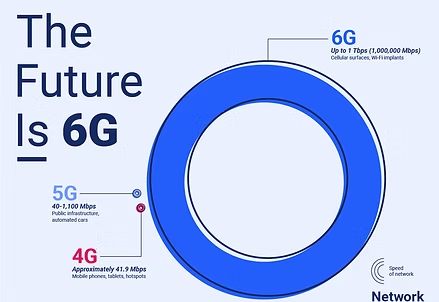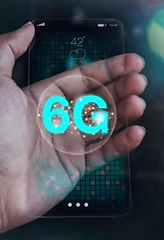6G COMING SOON?
What does this mean for you?
Although 5G wireless networks are still in their initial deployment stages, wireless communication companies are already setting their sights on the next evolution of mobile networks: 6G.
In reality, 6G has not yet materialized, but it exists as a concept that experts are envisioning. 6G represents the forthcoming phase of wireless technology, integrating innovative elements such as edge computing, artificial intelligence, and terahertz waves to usher in an entirely new era of the internet. With 6G, internet speeds could potentially skyrocket to a thousand times faster than current standards, and latency could plummet to as low as one millisecond. Conventional Wi-Fi devices like laptops and smartphones might give way to cutting-edge technologies like cellular surfaces and even Wi-Fi implants. Yes, you read that correctly, implants.
While all of this remains purely theoretical at present, a growing interest in the field has spurred government investments in research and fostered collaborations between universities and telecommunications companies. So, let's embark on a deep exploration into the realm of 6G and dare to imagine what the future may hold.

4G vs. 5G vs. 6G
The Gradual Evolution Of Wireless Technology
| Network | Speeds | Supported devices |
|---|---|---|
| 4G | Appr. 41.9 Mbps | Mobile phones, tablets, hotspots |
| 5G | 40-1100 Mbps | Mobile phones, tablets, hotspots, public infrastructure, automated-cars |
| 6G | Up to 1 Tbps (1,000,000 Mbps) | Automated cars, cellular surfaces, Wi-Fi implants |
6G FREQUENTLY ASKED QUESTIONS:
What does 6G mean?
6G stands for "sixth generation." It represents the forthcoming wireless internet and communications standard, succeeding 5G and 4G.

What is 6G?
6G is primarily a theoretical concept encompassing a set of ideas and hypotheses regarding the future landscape of mobile networks, Wi-Fi devices, connected vehicles, and various Wi-Fi-enabled devices expected to emerge in a decade or so. It serves as the envisioned future of wireless internet, shaped by the perspectives of academics and industry stakeholders.
What will 6G looks like?
While the precise appearance of 6G remains uncertain, it is likely to involve a heightened level of automation and connectivity in domains such as automobiles, drones, mobile devices, homes, and industries. Additionally, 6G will incorporate cutting-edge technologies like artificial intelligence and advanced "edge computing" to enhance network sophistication. This will enable unprecedented internet speeds and instantaneous latency, facilitating the coordination of intricate systems such as traffic management and stock markets.
What is a 6G Base Station
A 6G base station is a wireless communication facility employed for the reception and transmission of cellular signals. Although 6G base stations are not yet in existence, 4G LTE and 5G networks rely on cell towers and "small cells," which are compact transmitters installed on street corners and utility poles, to deliver internet and cellular data to our phones and other wireless devices.
What does 6G mean for my safety?
At The EMF Pro, we hold unwavering confidence in the effectiveness of our products, not only against 6G and all other non-ionic frequencies (typically below X-ray levels) but also in their potential to allow us to thrive in our high-tech society while maintaining better health than what was experienced in the 1980s concerning EMFs.
Our solutions cover a wide spectrum of frequencies, spanning from the 60 Hz of electricity (measured in Hertz or "waves per second") to an extensive range of up to 100,000 Hz, commonly referred to as "Dirty Electricity." We extend our protection to encompass 2G, 3G, 4G (including frequencies of up to 5 billion Hz), as well as 5G, 6G, and beyond. Our assurance stems from rigorous testing and the validation of our theories. These various frequencies all contribute to the same challenge: Subatomic Chaos, explained in detail in our "How it Works" section.
How can I protect myself from 6G radiation?
As you read this article, rest assured that by employing our effective solutions to mitigate EMFs, you can enjoy peace of mind. However, we strongly recommend staying connected with us over the years, either through social media or our website (theemfpro.com). EMFs are poised to increase over time, and we are committed to keeping you informed about when it becomes necessary to enhance your protection, ensuring nearly 100% remediation wherever you go.
Solutions
Education
Contact
Follow
© Copyright 2025. The EMF Pro. All Rights Reserved.
